Category: Architecture & Art Forms
Jallikattu
11, Jan 2022
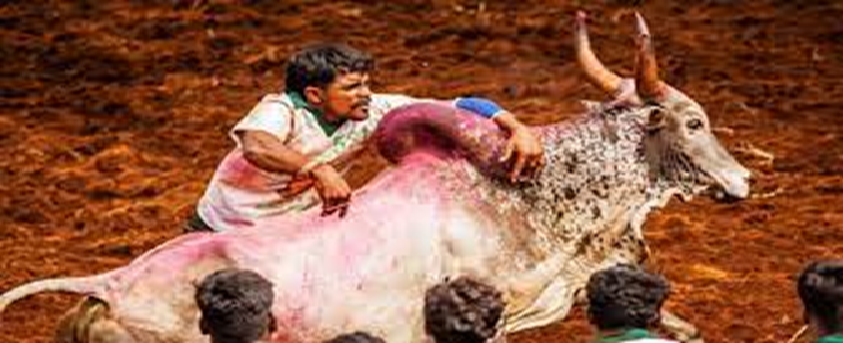
Why in News?
- With a steep rise in the daily cases of COVID-19, the district administration in Vellore, Tiruvannamalai, Ranipet and Tirupattur, have banned the conduct of Jallikattu events, ahead of Pongal festival, as part of Safety Measures.
What is Jallikattu?
- The bull-taming sport is popular in Madurai, Tiruchirappalli, Theni, Pudukkottai and Dindigul districts known as the Jallikattu belt.
- Jallikattu is celebrated in the second week of January, during the Tamil harvest festival, Pongal.
- A tradition over 2,000 years old, Jallikattu is a competitive sport as well as an event to honour bull Owners who rear them for Mating.
- It is a violent sport in which contestants try to tame a bull for a prize; if they fail, the bull Owner Wins the Prize.
Why is Jallikattu Important in Tamil culture?
- Jallikattu is considered a traditional way for the peasant community to preserve their pure-breed native bulls.
- At a time when cattle breeding is often an artificial process, conservationists and peasants argue that Jallikattu is a way to protect these male animals which are otherwise used only for Meat if not for Ploughing.
Why has Jallikattu been the Subject of Legal Battles?
- Jallikattu first came under legal scrutiny in 2007 when the Animal Welfare Board of India and the animal rights group PETA moved petitions in the Supreme Court against Jallikattu as well as bullock cart races.
- The Tamil Nadu government, however, worked its way out of the ban by passing a law in 2009, which was signed by the Governor.
- In 2011, the UPA regime at the Centre added bulls to the list of animals whose training and exhibition is prohibited.
- In May 2014, days before the BJP was elected to power, the Supreme Court banned the bull-taming sport, ruling on a petition that cited the 2011 notification.
So, is it legal or Banned Now?
- In January 2017, massive protests erupted across Tamil Nadu against the ban, with Chennai city witnessing a 15-day-long Jallikattu uprising.
- The same year, the Tamil Nadu government released an ordinance amending the central Act and allowing Jallikattu in the state; this was later ratified by the President.
- The amendment was subsequently approved by the President of India, effectively overturning the Supreme Court ban and allowing the sport to be played without any legal hurdle.
- PETA challenged the state move, arguing it was unconstitutional (Article 29(1)).
- In 2018, the Supreme Court referred the Jallikattu case to a Constitution Bench, where it is Pending Now.
IMPLEMENTS WERE RECOVERED FROM THE MALAMPUZHA DAM’S CATCHMENT AREA
18, Jul 2019

- Context– Iron implements were recovered from the Malampuzha dam’s catchment area
- Implements belonging to the Iron Age.
What is Iron age:
- The Iron Age is the final epoch of the three-age division of the prehistory and protohistory of humanity.
- It was preceded by the Stone Age.
Location:
- Catchment area of the Malampuzha dam.
- Dateable to over 2,000 years ago, the relics have retained memories of an age which began agriculture in the south.
- The plains between the hills could most probably have been used for farming by the people who erected the burials on the slopes and tops of the hills nearby.
- One of the cist burials huge in size and has four chambers which are unusual.
Findings:
- The iron implements found include a nail, a chisel, a wedge, a knife and a dagger.
- The broken pieces of the dagger were recovered from a cist found at the location.
- Knife was found beside another cist, the nail, chisel, wedge and two other tools were recovered from the top of a broken urn at South Malampuzha.
- Tools that could not be identified might be a spearhead and the top portion of a sickle.
Iron Age burials:
- During the iron age, people had used huge earthen jars for burying the mortal remains of the dead.
- The iron age burials are the evidence for secondary burials which was practiced during that period.
- Most of the burials have been destroyed.
- At many sites, post holes have also been found indicating that they could have been us
MARKANDESHWAR TEMPLE
17, Jul 2019
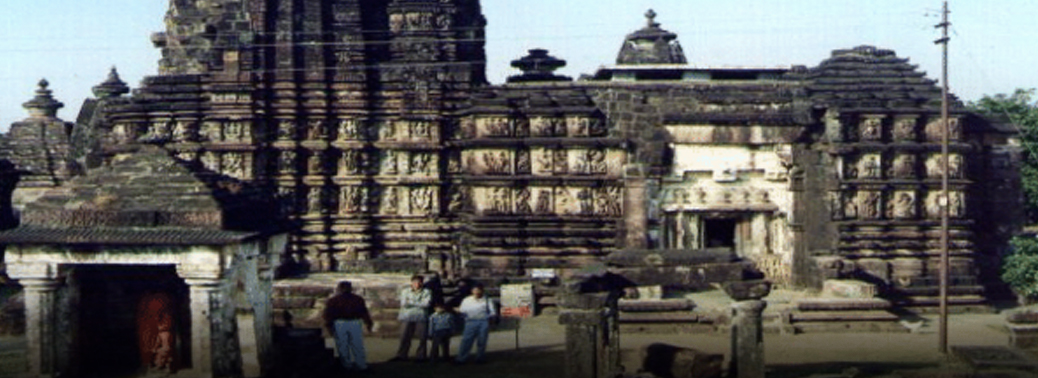
- Context– The restoration work of Markandeshwar temple in Maharashtra by the Archaeological Survey of India Known as the “Khajuraho of Vidarbha”,the temple of Markandadeo is situated on the bank of River Wainganga in district Gadchiroli of Maharashtra.
Features:
- The temples belong to the Nagara group of temples of North India.
- On stylistic grounds, their date ranges in between 9-12th centuries CE.
- The temples belong to saiva, vaishnava and sakta faith.
- Most of the temples have a simple plan, With Ardhamandapa, Mandapa, Antarala and Garbhagriha forming the component of the entire set up.
- Shikhara of the main shrine and mahamandapa was struck by a lightning which led to the partial collapse of the shikhara.
- Nagara style
- The northern-style (Nagara), Shikhara is shaped like a beehive and is made up of layer upon layer of architectural elements called kapotas and gavakshas
Gond Ruler:
- The then Gond Ruler renovated the temple about 120 years ago, trying to restore the fallen portions as much as possible.
JAIPUR CITY DECLARED AS A WORLD HERITAGE SITE
07, Jul 2019
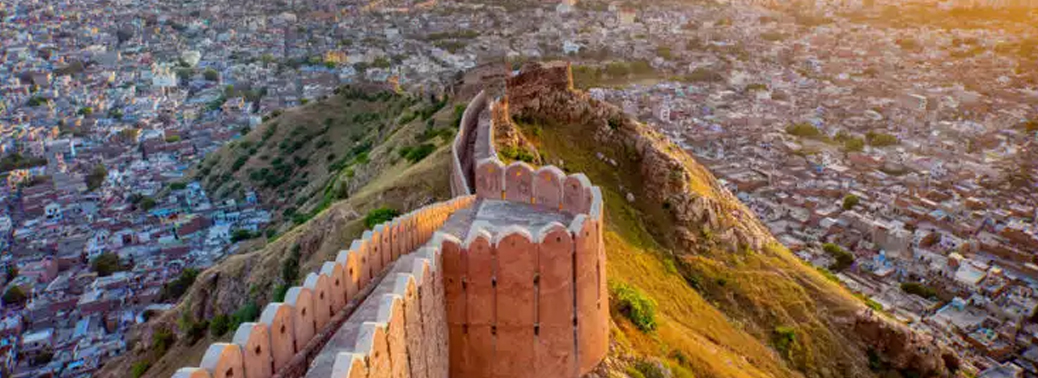
Why in News?
- Jaipur City, Rajasthan got inscribed on the World Heritage List of UNESCO during the 43rd Session of the World Heritage Committee held at Baku, Azerbaijan.
Highlights:
- India’s nomination of the Jaipur City, Rajasthan got inscribed on the World Heritage List of UNESCO during the 43rd Session of the World Heritage Committee held at Baku, Azerbaijan.
- The nomination of Jaipur City has successfully been done by complying with the various UNESCO guidelines of 2017. With Successful inscription of Jaipur City,India has 38 world heritage sites , that include 30 Cultural properties, 7 Natural properties and 1 mixed site. India’s nomination was initially recommended by the ICOMOS (advisory body of World Heritage (WH)Centre for cultural sites) as Deferral, but the 21 nation World Heritage Committee debated it and after discussion decided to inscribe it on the World Heritage list.
Why Jaipur?
- The City of Jaipur is an exceptional urban example in indigenous city planning and construction in South Asia.
- Unlike other medieval cities of the region, Jaipur was deliberately planned as a new city on the plains open for trade as opposed to hilly terrain and military cities of past, though its planning still ensured a response to the surrounding hill tops in all directions.
- The site selected within the valley that lay to the south of Amber hills was comparatively flat and unmarred by any previous construction.
- Besides an exemplary planning, its iconic monuments such as the Govind Dev temple, City Palace, Jantar Mantar and Hawa Mahal excel in artistic and architectural craftsmanship of the period.
- Jaipur is an expression of the astronomical skills, living traditions, unique urban form and exemplary foresighted city planning of an 18Th century city from India.
- Jaipur is an exemplary development in town planning and architecture that demonstrates amalgamation and important interchange of several ideas over the late medieval period.
World Heritage Committee:
- The World Heritage Committee is composed of representatives of 21 States Parties to the World Heritage Convention who meet annually.
- The Committee is in charge of implementing the Convention.
- To date, 1,092 sites in 167 countries have been inscribed on the World Heritage List.
Significance:
- It brings international attention to the need for the preservation and conservation of the site.
- It brings tourism to the site, with its accompanying economic benefits to the host country and local area.
- It can provide funds for restoration, preservation, and training. For example, in 2001, the Taliban destroyed two 6th century, 150-ft. statues of Buddha carved into the mountainside in the Bamiyan Valley in Afghanistan. The site has received more than $4 million from UNESCO to help with reconstruction and to hire a sculptor to re-carve some of the damaged stone.
- It promotes national and local pride in the natural and man-made wonders of the country. It promotes close ties with the United Nations system and the prestige and support it provides.
- It provides access to global project management resources.
- It facilitates creating partnerships between government, the private sector, and NGOs to achieve conservation goals.
- The site is protected under the Geneva Convention against destruction or misuse during wartime.
Selection Criteria:
- To represent a masterpiece of human creative genius
- To exhibit an important interchange of human values, over a span of time or within a cultural area of the world, on developments in architecture or technology, monumental arts, town-planning or landscape design;
- To bear a unique or at least exceptional testimony to a cultural tradition or to a civilization which is living or which has disappeared
- To be an outstanding example of a type of building, architectural or technological ensemble or landscape which illustrates (a) significant stage(s) in human history;
- To be an outstanding example of a traditional human settlement, land-use, or sea-use which is representative of a culture (or cultures), or human interaction with the environment especially when it has become vulnerable under the impact of irreversible change;
- To be directly or tangibly associated with events or living traditions, with ideas, or with beliefs, with artistic and literary works of outstanding universal significance. (The Committee considers that this criterion should preferably be used in conjunction with other criteria);
- To contain superlative natural phenomena or areas of exceptional natural beauty and aesthetic importance;
- To be outstanding examples representing major stages of earth’s history, including the record of life, significant on-going geological processes in the development of landforms, or significant geomorphic or physiographic features;
- To be outstanding examples representing significant on-going ecological and biological processes in the evolution and development of terrestrial, fresh water, coastal and marine ecosystems and communities of plants and animals;
- To contain the most important and significant natural habitats for in-situ conservation of biological diversity, including those containing threatened species of outstanding universal value from the point of view of science or conservation.
Types of World Heritage Sites:
- Cultural Heritage Sites include hundreds of historic buildings and town sites, important archaeological sites, and works of monumental sculpture or painting.
- Natural Heritage Sites are restricted to those natural areas that (1) furnish outstanding examples of Earth’s record of life or its geologic processes, (2) provide excellent examples of ongoing ecological and biological evolutionary processes, (3) contain natural phenomena that are rare, unique, superlative, or of outstanding beauty, or (4) furnish habitats for rare or endangered animals or plants or are sites of exceptional biodiversity.
- Mixed Heritage Sites contain elements of both natural and cultural significance.
Process of getting into the list:
- The first step involves creating a detailed dossier showing the outstanding universal value of the site, besides meeting a few other criteria.
- Once the documentation is complete, it requires a push by the State party or the country where the site is located.
- The property is then evaluated by the International Council on Monuments and Sites (ICOMOS) and the International Union for Conservation of Nature (IUCN).
- The International Centre for the Study of the Preservation and Restoration of Cultural Property (ICCROM) then provides advice on conservation of the site, and training.
- After all these steps, the World Heritage Committee evaluates the site and decides to inscribe it or send back the nomination.
Pandharpur Wari
30, Jun 2019
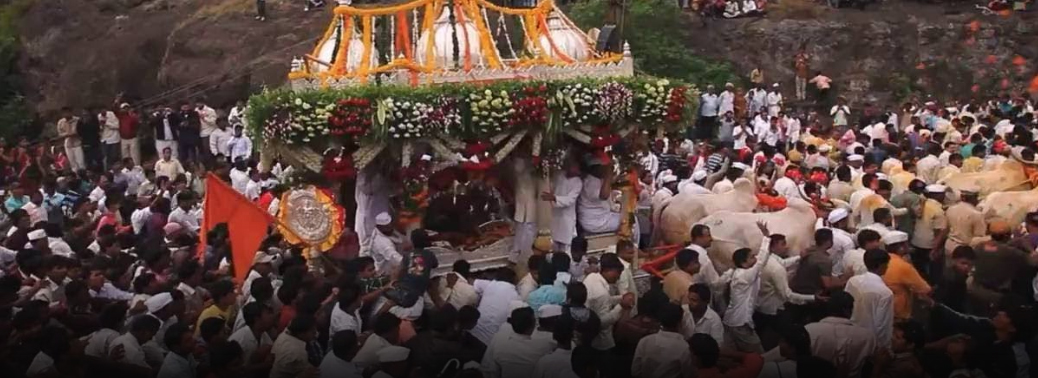
- Pandharpur Wari is related to Bhakti Movment
- It is an annual pilgrimage (yatra) to Pandharpur – the seat of the Hindu god Vithal in
- Palakhis (palanquin processions) carrying the paduka (foot prints) of various saints – most notably Dnyaneshwar and Tukaram – from the Varkari (Warkari, “one who performs the Wari”) sect (which venerates Vithal), are taken from their respective shrines to Pandharpur.
Bhakti Movement
- As a social movement, the Bhakti movement, challenged caste hierarchy, emphasized the individual’s direct connection to god and the possibility of salvation for all through good deeds and simple living.
- In Maharashtra, the Bhakti movement began in the late 13th century.
- Its proponents were known as the Varkaris.
- Among its most popular figures were Jnanadev (1275- 96),Namdev (1270-50) and Tukaram (1608-50), who have left behind many verses that embody the essence of Bhakti.
Tukaram
- Saint of the Bhakti movement in Maharashtra,
- Tukaram is best known for his devotional poetry called Abhanga and community-oriented worship with spiritual songs known as kirtans
- He was part of the egalitarian, personalized Varkari devotionalism tradition
- Tukaram was a rebel from Shudra by caste,
- Defying the injunctions of the Brahmins, Tukaram chose to write on religious matters, and that too in Marathi, the language of the people.
Namdev
- was an Indian poet and saint from Maharashtra,
- writings were also recognized by the “Gurus” of Sikhism and are included in the holy book of Sikhism, the Sri Guru Granth Sahib.
- Namdev was influenced by Vaishnavism.
- His philosophy contains both nirguna and saguna Brahman elements.
Dnyaneshwar
- was a 13th-century Marathi saint, poet, philosopher and yogi of the Nath Vaishnava tradition.
- Dnyaneshwar’s ideas reflect the non-dualistic Advaita Vedanta
- His legacy inspired saint-poets such as and Tukaram
RED FORT
25, Jun 2019
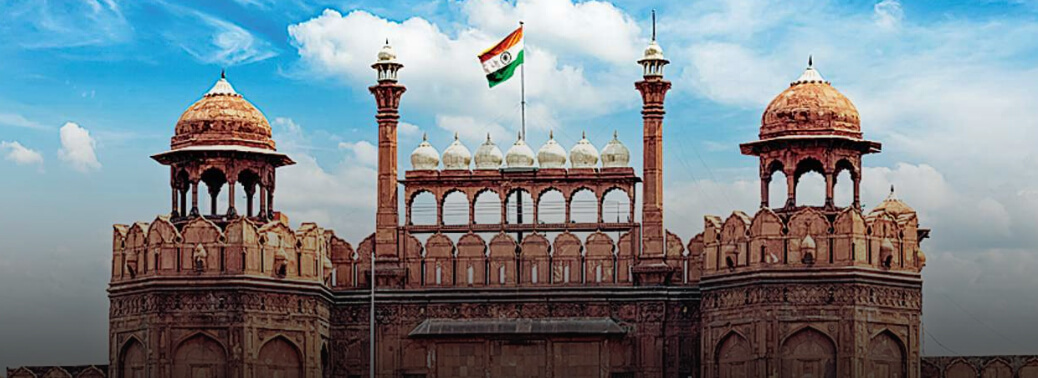
Context:
ASI carries out restoration of Mughal •era parts of Red Fort.
About:
- Red fort fuses architectural styles of the Timurids and the Persians.
- Red Fort has many structures that serve as fine examples of Islamic architectural style and Mughal architecture,
- Built By: Shah Jahan
- Architect: Ustad Ahmad Lahauri Architectural styles: Mughal, Indo-Islamic Current Status: UNESCO World Heritage Site On the Banks of River Yamuna,
- The Red Fort is known for its gardens and a water channel called The Stream of Paradise.
Salient Features of Indo-Islamic Architecture:
- Islamic Architecture is characterised by a few Visible Symbols.
- One is the arch, which frames the space;
- second symbol is the dome, which looms over the skyscape;
- third is the Minaret, which pierces the skies. Minarets were Actually Symbols in the Middle of Deserts
- Muslims forbidden to replicate living forms on any surface, developed their religious art and architecture consisting of the arts of arabesque, geometrical patterns and calligraphy on plaster and stone.
Indian Indo Islamic Architecture:
- The Indo-Islamic architecture inculcates the elements of Saracenic, Turkish and Arab architecture
- The first new element added in the Indian architecture was the use of shapes instead of natural forms. This apart, use of calligraphy as inscriptional art was also a new element added to by Muslims
- Inlay decoration and use of coloured marble, painted plaster and brilliantly glazed tiles.
Indo-Islamic architecture is conventionally categorised into the following four Categories:
- Imperial Style (Delhi Sultanate)
- Provincial Style (Mandu, Gujarat, Bengal, and Jaunpur)
- Mughal Style (Delhi, Agra, and Lahore)
- Deccani Style (Bijapur, Golconda).
The Building Material:
- One thing is very common in these buildings that the walls are extremely thick and largely constructed of Rubble masonary, which was easily available.
- These walls were then cased over with limestone plaster or dressed stone.
- A variety of stones were used such as Quartzite, Sandstone, Buff, Marble, etc. In some cases, the Polychrome Tiles were used to finish the walls.
5th INTERNATIONAL DAY OF YOGA
21, Jun 2019

- International Day of Yoga, is celebrated annually on 21 June every year since 2015.
- International day for yoga was declared unanimously by the United Nations General Assembly (UNGA).
- It was inscribed in the representative list of Intangible Cultural Heritage of Humanity by UNESCO in December 2016.
About YOGA:
- Yoga, a school emphasizing meditation, contemplation and liberation.
- Yoga is an ancient physical, mental and spiritual practice.
- The Yoga philosophical system is closely allied with the Samkhya school, but is more theistic than the Samkhya.
- The foundational text of the Yoga school is the Yoga Sutras of Patanjali, who is regarded as the founder of the formal Yoga philosophy.
Hindu philosophy distinguishes seven major branches of Yoga:
- Raja Yoga (Classical Yoga), a system of yoga codified by Patañjali and classified as one of the six āstika (“orthodox”) schools of Hindu philosophy.
- Jnana yoga, (buddhi-yoga) centred on the faculty of discernment and ‘virtually identical with the spiritual path of Vedānta’.
- Karma-yoga, in which the world of everyday work becomes the tool by which self is transcended.
- Bhakti-Yoga the path of devoted service to God.
- Tantra-yoga focused on the techniques and psycho-physical teachings contained within a body of texts called tantras.
- Mantra-Yoga, one of the most ancient forms of yoga in which the psycho-acoustical properties of the spoken word are used to concentrate the mind.
- Hatha Yoga, a system of physical purification designed to reintegrate and re-balance the mind and body in preparation for Raja-yoga (first described by Yogi Swatmarama).
ASI IDENTIFIES INDIAN ARTEFACTS SEIZED FROM SMUGGLER
09, May 2019
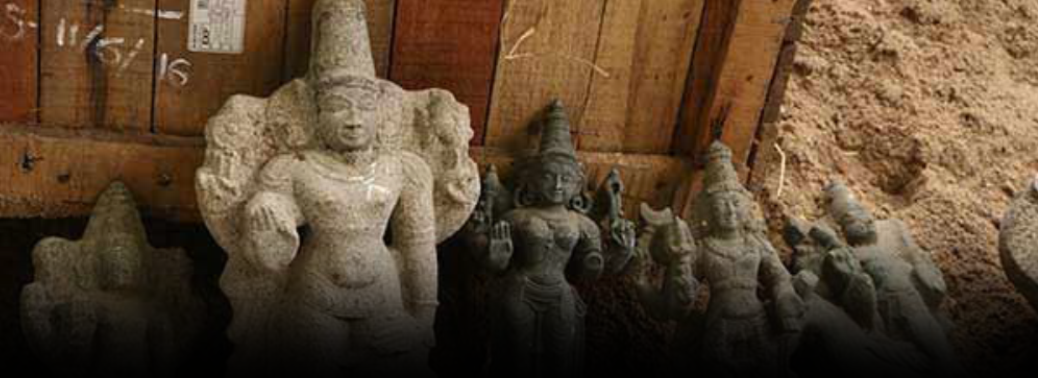
Why in News:
- From idols dating back to the Gupta period (5th-6th Century AD) to terracotta objects of the Harappan culture, a range of Indian antiquities and artefacts that were smuggled identified by the Archaeological Survey of India (ASI) during a team’s recent visit to the United States.
Details:
- “The antiquities comprise beautiful bronzes from the Suttamalli and Sripurantan temples of
- Tamil Nadu and also a very significant image of Mahakoka Devata.
- Of these, four antiquities were stolen from the protected monuments at Karitalai, district Katni in Madhya Pradesh.
- Apart from that, 56 terracotta objects that were returned by Toledo Museum in Ohio to the Indian consulate were declared to be antiquities by the team.
- Among them, few were identified as antiquities, like the stone image of the Buddha of Mathura School, a terracotta image of the Buddha belonging to the Gupta period and a set of 10 copper plates engraved with Quranic verses of the late Mughal Period,
Archaeological Survey of India (ASI)
- The ASI is the premier organization for the archaeological researches and protection of the cultural heritage of the country.
- The prime objection of ASI is to maintain the archaeological sites, ancient monuments and remains of national importance.
- Headquarters: New Delhi.
- Established: 1861 by Alexander Cunningham.
- It regulates all archaeological activities as per the provisions of the Ancient Monuments and Archaeological Sites and Remains Act, 1958.
- It functions under the aegis of the Union Ministry of Culture. It also regulates Antiquities and Art Treasure Act, 1972.
PM TO UNVEIL PATEL STATUE
23, Oct 2018
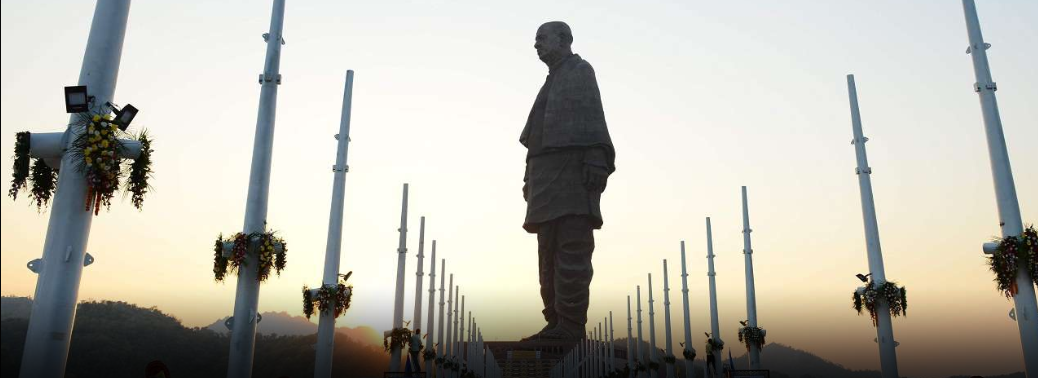
Why in News?
- Prime Minister Narendra Modi is set to unveil Sardar Patel’s statue, the world’s largest, on his birth anniversary on October 31.
About the News:
- Final touches are being given to the Statue of Unity, as it is called, built by engineering and infrastructure major L&T on the river Narmada in South Gujarat. The world’s highest 182-metre statue will get flypast from the Indian Air Force team of Surya Kiran that will display Tricolour in sky when PM will switch on the button to inaugurate the statue.
- The statue has been under construction for nearly four years.
- The Statue of Unity, which is twice the size of the Statue of Liberty, has been built in a remote corner of Gujarat as a flagship project of Modi who is to open it on 31st October.
- The Rs. 3,000 crore projects are funded for the most part by the Gujarat government, with minor contributions from the Centre and Central PSUs.
- This is a tribute to Sardar Patel, who united the country after Independence. It’s a tribute by the nation and the State he was born in.
- The statue is made up of 1,700 tonnes of bronze, 1,850 tonnes of bronze cladding, 70,000 metric tonnes of cement and 24,500 metric tonnes of steel.
- Two high speed elevators inside can take tourists up to the statue’s chest from where around 200 visitors can view the Narmada river and the Sardar Sarovar dam over it.
GOLD FOUND AT KEEZHADI
22, Oct 2018

Why in News?
- The State Department of Archaeology told the Madurai Bench of the Madras High Court that it has applied to the Union Ministry of Culture for starting the fifth phase of the excavations at Keezhadi near Madurai following the completion of the fourth phase.
Background:
- Political controversy has again erupted around Keezhadi (also known as Keeladi), a major archaeological site in Tamil Nadu, four years after excavators began to unearth the remains of an ancient urban civilization that thrived on the banks of the river Vaigai more than 2,000 years ago.
- While delayed allocation of funds and alleged reluctance of the Union government to continue with the excavation led to widespread condemnation in 2016, a year later the transfer of superintending archaeologist K. Amarnath Ramakrishnan led to further protests. The latest round of controversy erupted last week when Ramakrishnan, who is posted in Assam and has submitted an interim report on Keezhadi, was denied permission to write the final report.
- Earlier this year, the Madras high court expressed its displeasure over ASI’s lack of interest in carrying out work at Adichanallur site in Thoothukudi where traces of Iron Age people, whose skeletal remains buried in big urns have been identified.
Phases of Keezhadi Excavation:
- In 2013-14, ASI carried out explorations along the Vaigai river valley in 293 sites in districts of Theni, Dindigul, Madurai, Sivaganga and Ramanathapuram. Keezhadi in Sivaganga was chosen for excavation.
- During the second phase of the excavation, the artifacts unearthed by the team led by Ramakrishnan established a substantial evidence that an ancient urban civilization had thrived on the banks of Vaigai. Last year, carbon dating of charcoal found at the site confirmed that the settlement was from 200BCE.
- More than 8,000 artefacts including pottery with Tamil Brahmi inscriptions, gold coins, beads, iron tools and jewellery, that were unearthed indicated that an urban civilization had existed during the Sangam era — between the 4th century BCE and 2nd century CE that is regarded as a golden era for Tamil language, literature and culture — and that it had trade link with other civilizations including Rome.
- While the third phase was led by ASI, the Tamil Nadu archaeology department after obtaining approval from Central Advisory Board of Archaeology (CABA) began the fourth phase earlier this year.
- Tamil Nadu archaeology department confirmed that the fourth phase is complete with the excavation of more than 7,000 antiques and document preparation is underway.
- The state archaeology department has requested the CABA to permit excavation for the next phase too and will start work by the beginning of next year if approval is granted.
Archaeological Survey of India (ASI):
- The Archaeological Survey of India (ASI) is a Government of India (Ministry of Culture) organisation responsible for archaeological research and the conservation and preservation of cultural monuments in the country. It was founded in 1861 by the British Raj.
- ASI was founded in 1861 by Alexander Cunningham who also became its first Director-General. The first systematic research into the subcontinent’s history was conducted by the Asiatic Society, which was founded by the British Indologist William Jones on 15 January 1784. Based in Calcutta, the society promoted the study of ancient Sanskrit and Persian texts and published an annual journal titled Asiatic Researches. Notable among its early members was Charles Wilkins who published the first English translation of the Bhagavad Gita in 1785 with the patronage of the then Governor-General of India, Warren Hastings. However, the most important of the society’s achievements was the decipherment of the Brahmi script by James Prinsep in 1837. This successful decipherment inaugurated the study of Indian palaeography.
- The Archaeological Survey of India is an attached office of the Ministry of Culture. Under the provisions of the AMASR Act of 1958, the ASI administers more than 3650 ancient monuments, archaeological sites and remains of national importance. These can include everything from temples, mosques, churches, tombs, and cemeteries to palaces, forts, step-wells, and rock-cut caves. The Survey also maintains ancient mounds and other similar sites which represent the remains of ancient habitation.
- The ASI is divided into a total of 29 circles each headed by a Superintending Archaeologist.
WORLD PEACE MONUMENT
22, Oct 2018
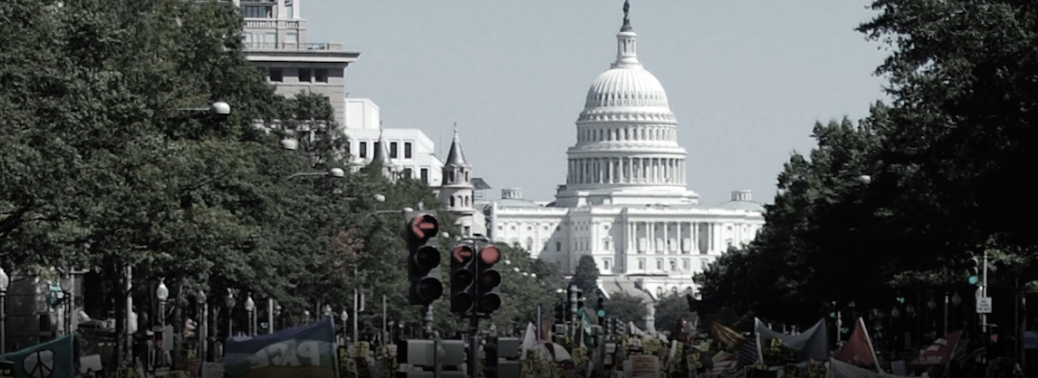
Why in News?
- Vice-President M. Venkaiah Naidu inaugurated the world’s largest dome at the Maharashtra Institute of Technology (MIT)’s World Peace University (MIT-
WPU) campus at Loni Kalbhor on the occasion of the 150th birth anniversary of Mahatma Gandhi.
Background:
- Institute authorities have said the structure, called the ‘World Peace Monument’ dome, took nearly 13 years to build. At 160 ft in diameter and 263 ft tall, it is larger in area than the dome at St. Peter’s Basilica in Vatican City (which is 136 ft. in diameter and 448 ft. in height).
- It is the outcome of 13 years of sheer dedication and untiring efforts against all odds by a teacher, Dr. Vishwanath Karad, who was deeply inspired by the teachings of apostles, saints, philosophers and scientists down the ages. He said that the world is one family – ‘Vasudhaiva Kutumbakam’ – which is an ancient Indian concept and it is a humble attempt to create an edifice befitting the glory of Mother India
- It is supported by 24 massive columns, each 63 feet tall, at the periphery of the dome and underneath — inside and outside — stand imposing bronze statues of 54 of the biggest names in world history stand, irrespective of nationality or religion002E
- Among the statues are: Gautam Buddha, Jesus Christ, Mahavir, Moses, Guru Nanak and Mahatma Gandhi; intellectual giants like Confucius, Adi Shankaracharya, Aristotle, Aryabhatta, Socrates, Plato, Galileo and Copernicus; philosopher-saints like Dnyaneshwara, Tukaram, Abdullah Shah Qadri (famous as Baba Bulleh Shah), Francis D’Assissi, Peter, Mother Teresa and Kabir; and scientists like Albert Einstein, Thomas Alva Edison, C.V. Raman, Jagadish Chandra Bose and Marie S. Curie.
5000-YEAR-OLD ROCK PAINTINGS – ANJUKULIPATTI PAINTINGS
21, Oct 2018
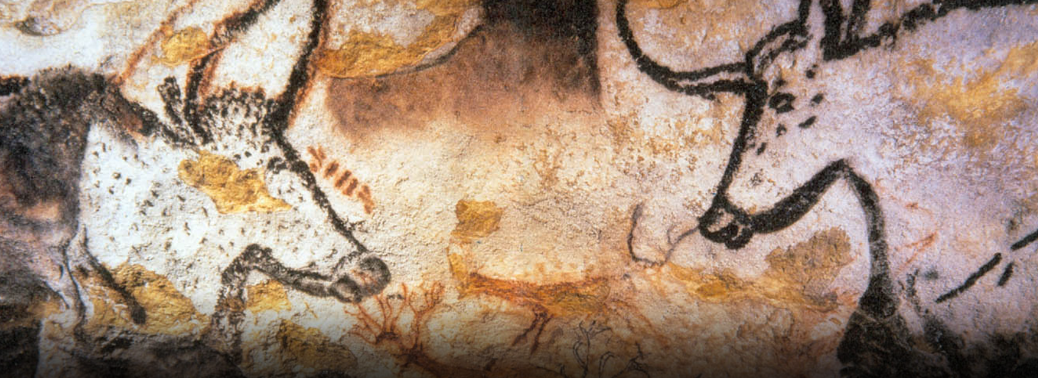
In News:
- For centuries, the fear of curse and death prevented the local people from visiting Ezhuthuparai (rock with writings and paintings) in
- Anjukulipatti on the Natham-Dindigul Road.
Background
- Believed to have been drawn between 3,000 and 3,500 BCE.Researchers spotted a panel of rock paintings belonging to a period between 3,000 BCE and 3,500 BCE.
- They are white in colour and the paintings are drawn using lime pigment mixed with animAal fat
- The panel has 56 paintings depicting tridents, spears, swords, horse and elephant riders, sacrifice of animals, mantras on energy and food, and lots of symbols.
- Though there are other paintings, they are in bad shape and cannot be deciphered.
- There are scenes either from a hunting expedition or a war. Similar paintings have been found in Sirumalai and the area is also a continuation of Sirumalai, though unexplored so far, He added that one important finding in the panel was a painting of sexual intercourse and a similar painting was found in Mallapadi in Dharmapuri district. Moreover, the human beings looked bulkier than they were in similar paintings found elsewhere.
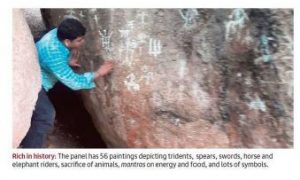
Other Rock paintings
- Bhimbetka Caves, Foothills of Vindhya, Madhya Pradesh. One of the oldest paintings in India and the world (Upper paleolithic).
Jogimara caves, Amarnath, Madhya Pradesh.
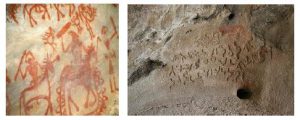
UNESCO World Heritage site
02, Jul 2018
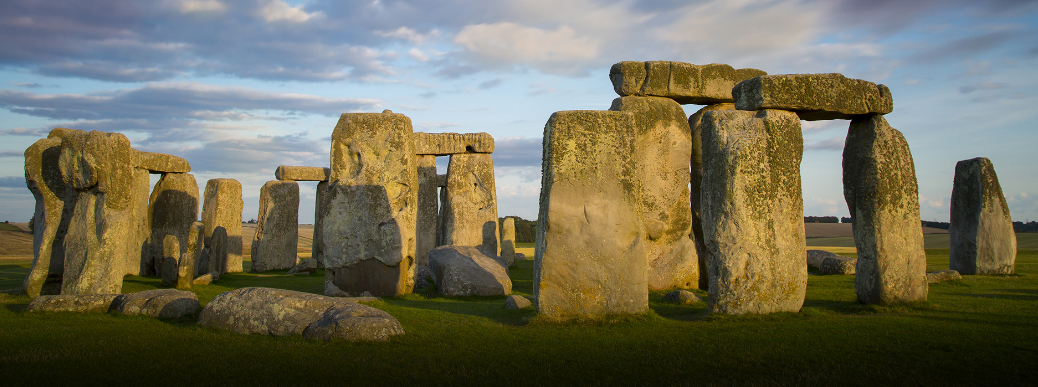
- Mumbai’s Art Deco buildings from India is added to UNESCO World Heritage Sites.
- Mumbai’s Art Deco buildings, it ensembles bear testimony to the phases of modernization that Mumbai has undergone in the course of the 19th and 20th centuries.
Other sites in Maharashtra are:
- Ellora caves
- Ajanta caves
- Elephant caves
- Chhatrapati Shivaji Maharaj Terminus
- Western Ghats
India now houses totally 37 UNESCO World Heritage sites.
UNESCO World Heritage Site:
Is a landmark or area which is selected by the UN Educational, Scientific and Cultural Organization (UNESCO)as having cultural, historical, scientific or other form of significance, and is legally protected by international treaties download from collectiveray.
It came by Convention Concerning the Protection of the World Cultural and Natural Heritage signed by UNESCO members.
It establish World Heritage Committee comprises of 15 State parties to convention.
Procedure
- Every State Party to this Convention shall, in so far as possible, submit to the World Heritage Committee an inventory of property forming part of the cultural and natural heritage, situated in its territory
- A country must first list its significant cultural and natural sites; the result is called the Tentative List.
- Next, it can place sites selected from that list into a Nomination File.
- The Nomination File is evaluated by the International council on monuments and sites and the World Conservation Union.
- These bodies then make their recommendations to the World Heritage Committee. The Committee meets once per year to determine whether or not to inscribe each nominated property on the World Heritage List and sometimes defers or refers the decision to request more information from the country which nominated the site.
Selection Criteria
Cultural criteria:
- Represents a masterpiece of human creative genius and cultural significance.
- Exhibits an important interchange of human values, over a span of time, or within a cultural area of the world, on developments in architecture or technology, monumental arts, town-planning, or landscape design.
- To bear a unique or at least exceptional testimony to a cultural tradition or to a civilization which is living or which has disappeared.
- Is an outstanding example of a type of building, architectural, or technological ensemble or landscape which illustrates a significant stage in human history.
- Is an outstanding example of a traditional human settlement, land-use, or sea-use which is representative of a culture, or human interaction with the environment especially when it has become vulnerable under the impact of irreversible change.
- Is directly or tangibly associated with events or living traditions, with ideas, or with beliefs, with artistic and literary works of outstanding universal significance.
Natural criteria:
- Contains superlative natural phenomena or areas of exceptional natural beauty and aesthetic importance.
- Is an outstanding example representing major stages of Earth’s history, including the record of life, significant on-going geological processes in the development of landforms, or significant geomorphic or physiographic features.
- Is an outstanding example representing significant on-going ecological and biological processes in the evolution and development of terrestrial, fresh water, coastal and marine ecosystems, and communities of plants and animals.
- contains the most important and significant natural habitats for in-situ conservation of biological diversity, including those containing threatened species of outstanding universal value from the point of view of science or conservation.
List of World Heritage in Danger:
A site may be added to the list of heritage site in danger if there are conditions that threaten the characteristics for which the landmark or area was inscribed on the World Heritage List. Such problems may involve armed conflict and war, natural disasters, pollution, poaching, or uncontrolled urbanization or human development.
Manas National park and group of Monuments at Hampi once listed in World heritage in danger, later it was removed by proper conservation.






